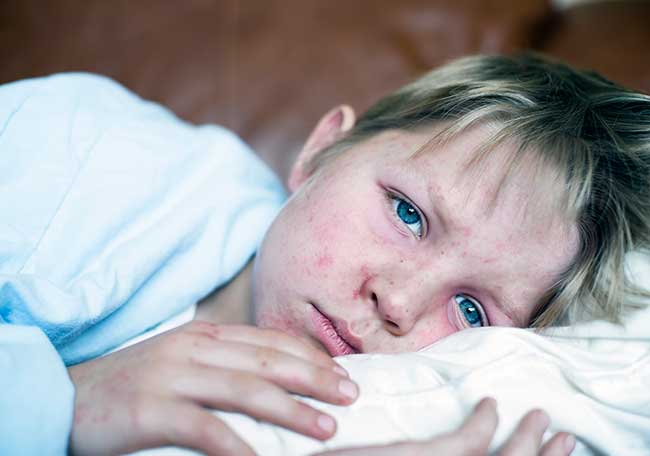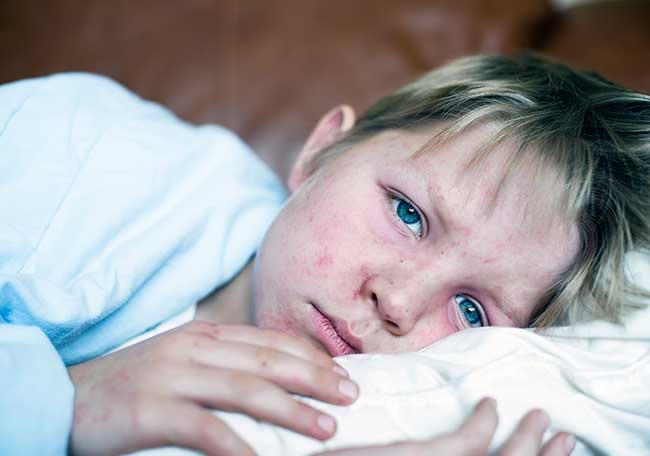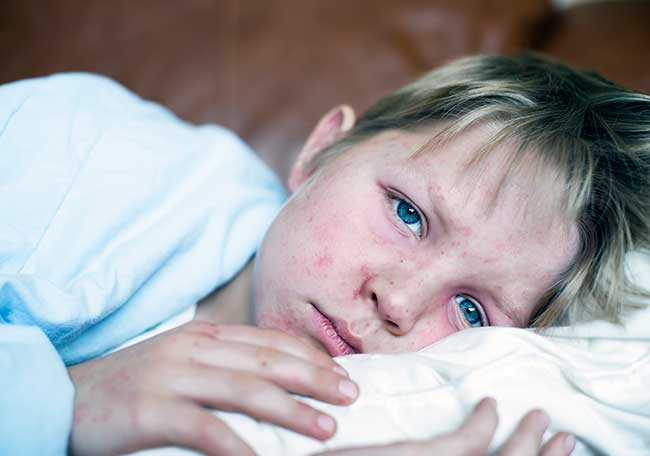Sarampión, una actualización imprescindible

1 Nambulli S, Sharp CR, Acciardo AS, Drexler JF, Duprex WP. Mapping the evolutionary trajectories of morbilliviruses: what, where and whither. Curr Opin Virol 2016; 16: 95–105.
2 Black FL. Measles endemicity in insular populations: critical community size and its evolutionary implication. J Theor Biol 1966; 11: 207–11.
3 Keeling MJ, Grenfell BT. Disease extinction and community size: modeling the persistence of measles. Science 1997; 275: 65–67.
4 Meeting of the International Task Force for Disease Eradication, November 2015. Weekly Epidemiol Rec 2016; 91: 61–71.
5 Moss WJ, Strebel P. Biological feasibility of measles eradication. J Infect Dis 2011; 204: S47–53.
6 Moss WJ, Griffin DE. Measles. Lancet 2012; 379: 153–64.
7 Shanks GD, Waller M, Briem H, Gottfredsson M. Age-specific measles mortality during the late 19th-early 20th centuries. Epidemiol Infect 2015; 143: 3434–41.
8 Mulders MN, Rota PA, Icenogle JP, et al. Global Measles and Rubella Laboratory Network Support for Elimination Goals, 2010–2015. MMWR Morb Mortal Wkly Rep 2016; 65: 438–42.
9 Patel MK, Gacic-Dobo M, Strebel PM, et al. Progress toward regional measles elimination—worldwide, 2000–2015. MMWR Morb Mortal Wkly Rep 2016; 65: 1228–33.
10 Simons E, Ferrari M, Fricks J, et al. Assessment of the 2010 global measles mortality reduction goal: results from a model of surveillance data. Lancet 2012; 379: 2173–78.
11 Liu L, Oza S, Hogan D, et al. Global, regional, and national causes of child mortality in 2000–13, with projections to inform post-2015 priorities: an updated systematic analysis. Lancet 2015; 385: 430–40.
12 McLean AR, Anderson RM. Measles in developing countries. Part I. Epidemiological parameters and patterns. Epidemiol Infect 1988; 100: 111–33.
13 McLean AR, Anderson RM. Measles in developing countries. Part II. The predicted impact of mass vaccination. Epidemiol Infect 1988; 100: 419–42.
14 Ferrari MJ, Grenfell BT, Strebel PM. Think globally, act locally: the role of local demographics and vaccination coverage in the dynamic response of measles infection to control. Phill Trans Royal Soc London B 2013; 368: 20120141.
15 Remington PL, Hall WN, Davis IH, Herald A, Gunn RA. Airborne transmission of measles in a physician’s office. JAMA 1985; 253: 1574–77.
16 Hope K, Boyd R, Conaty S, Maywood P. Measles transmission in health care waiting rooms: implications for public health response. West Pacific Surv Resp J 2012; 3: 33–38.
17 Sartwell PE. The incubation period and the dynamics of infectious disease. Am J Epidemiol 1966; 83: 204–06.
18 Lessler J, Reich NG, Brookmeyer R, Perl TM, Nelson KE, Cummings DA. Incubation periods of acute respiratory viral infections: a systematic review. Lancet Infect Dis 2009; 9: 291–300.
19 Fitzgerald TL, Durrheim DN, Merritt TD, Birch C, Tran T. Measles with a possible 23 day incubation period. Commun Dis Intel Quart Report 2012; 36: E277–80.
20 Riddell MA, Moss WJ, Hauer D, Monze M, Griffin DE. Slow clearance of measles virus RNA after acute infection. J Clin Virol 2007; 39: 312–17.
21 Fill MM, Sweat D, Morrow H, et al. Notes from the field: measles outbreak of unknown source - Shelby County, Tennessee, April–May 2016. MMWR Morb Mortal Wkly Rep 2016; 65: 1039–40.
22 Dietz K. The estimation of the basic reproduction number for infectious diseases. Stat Method Med Res 1993; 2: 23–41.
23 Anderson R MR. Infectious Diseases of Humans. Oxford: Oxford University Press, 1991.
24 Wallinga J, Heijne JC, Kretzschmar M. A measles epidemic threshold in a highly vaccinated population. PLoS Med 2005; 2: e316.
25 Jones-Engel L, Engel GA, Schillaci MA, et al. Considering human-primate transmission of measles virus through the prism of risk analysis. Am J Primatol 2006; 68: 868–79.
26 Fine PE, Clarkson JA. Measles in England and Wales—I: An analysis of factors underlying seasonal patterns. Int J Epidemiol 1982; 11: 5–14.
27 Ferrari MJ, Grais RF, Bharti N, et al. The dynamics of measles in sub-Saharan Africa. Nature 2008; 451: 679–84.
28 Albrecht P, Ennis FA, Saltzman EJ, Krugman S. Persistence of maternal antibody in infants beyond 12 months: mechanism of measles vaccine failure. J Pediatr 1977; 91: 715–18.
29 Leuridan E, Hens N, Hutse V, Ieven M, Aerts M, Van Damme P. Early waning of maternal measles antibodies in era of measles elimination: longitudinal study. BMJ 2010; 340: 1626.
30 Waaijenborg S, Hahne SJ, Mollema L, et al. Waning of maternal antibodies against measles, mumps, rubella, and varicella in communities with contrasting vaccination coverage. J Infect Dis 2013; 208: 10–16.
31 Durrheim DN, Crowcroft NS, Strebel PM. Measles—the epidemiology of elimination. Vaccine 2014;32: 6880–83.
32 Sugerman DE, Barskey AE, Delea MG, et al. Measles outbreak in a highly vaccinated population, San Diego, 2008: role of the intentionally undervaccinated. Pediatrics 2010; 125: 747–55.
33 Phadke VK, Bednarczyk RA, Salmon DA, Omer SB. Association between vaccine refusal and vaccine-preventable diseases in the United States: A review of measles and pertussis. JAMA 2016; 315: 1149–58.
34 De Serres G, Boulianne N, Defay F, et al. Higher risk of measles when the first dose of a 2-dose schedule of measles vaccine is given at 12-14 months versus 15 months of age. Clin Infect Dis 2012; 55: 394–402.
35 Defay F, De Serres G, Skowronski DM, et al. Measles in children vaccinated with 2 doses of MMR. Pediatrics 2013; 132: e1126–33.
36 Tatsuo H, Ono N, Tanaka K, Yanagi Y. SLAM (CDw150) is a cellular receptor for measles virus. Nature 2000; 406: 893–97.
37 Muhlebach MD, Mateo M, Sinn PL, et al. Adherens junction protein nectin-4 is the epithelial receptor for measles virus. Nature 2011; 480: 530–53.
38 Tahara M, Ohno S, Sakai K, et al. The receptor-binding site of the measles virus hemagglutinin protein itself constitutes a conserved neutralizing epitope. J Virol 2013; 87: 3583–86.
39 Plattet P, Alves L, Herren M, Aguilar HC. Measles virus fusion protein: structure, function and inhibition. Viruses 2016; 8: 112.
40 WHO. Measles virus nomenclature update: 2012. Wkly Epidemiol Rec 2012; 87: 73–81.
41 Mulders MN, Truong AT, Muller CP. Monitoring of measles elimination using molecular epidemiology. Vaccine 2001; 19: 2245–49.
42 Moss WJ, Scott S, Ndhlovu Z, et al. Suppression of human immunodeficiency virus type 1 viral load during acute measles. Pediatr Infect Dis J 2009; 28: 63–65.
43 Perry RT, Murray JS, Gacic-Dobo M, et al. Progress toward regional measles elimination—worldwide, 2000–2014. MMWR Morb Mortal Wkly Rep 2015; 64: 1246–51.
44 Penedos AR, Myers R, Hadef B, Aladin F, Brown KE. Assessment of the utility of whole genome sequencing of measles virus in the characterisation of outbreaks. PloS One 2015; 10: e0143081.
45 Gardy JL, Naus M, Amlani A, et al. Whole-genome sequencing of measles virus genotypes H1 and D8 during outbreaks of infection following the 2010 Olympic Winter Games reveals viral transmission routes. J Infect Dis 2015; 212: 1574–78.
46 Beaty SM, Lee B. Constraints on the genetic and antigenic variability of measles virus. Viruses 2016; 8: 109.
47 Enders JF, Peebles TC. Propagation in tissue cultures of cytopathogenic agents from patients with measles. Proc Soc Exp Biol Med 1954; 86: 277–86.
48 Fulton BO, Sachs D, Beaty SM, et al. Mutational analysis of measles virus suggests constraints on antigenic variation of the glycoproteins. Cell Reports 2015; 11: 1331–38.
49 de Swart RL, Ludlow M, de Witte L, et al. Predominant infection of CD150+ lymphocytes and dendritic cells during measles virus infection of macaques. PLoS Pathog 2007; 3: e178.
50 Ludlow M, de Vries RD, Lemon K, et al. Infection of lymphoid tissues in the macaque upper respiratory tract contributes to the emergence of transmissible measles virus. J Gen Virol 2013; 94: 1933–44.
51 Singh BK, Li N, Mark AC, Mateo M, Cattaneo R, Sinn PL. Cell-to-cell contact and nectin-4 govern spread of measles virus from primary human myeloid cells to primary human airway epithelial cells. J Virol 2016; 90: 6808–17.
52 Ludlow M, McQuaid S, Milner D, de Swart RL, Duprex WP. Pathological consequences of systemic measles virus infection. J Pathol 2015; 235: 253–65.
53 Leonard VH, Sinn PL, Hodge G, et al. Measles virus blind to its epithelial cell receptor remains virulent in rhesus monkeys but cannot cross the airway epithelium and is not shed. J Clin Invest 2008; 118: 2448–58.
54 de Vries RD, Mesman AW, Geijtenbeek TB, Duprex WP, de Swart RL. The pathogenesis of measles. Curr Opin Virol 2012; 2: 248–55.
55 Lin WH, Kouyos RD, Adams RJ, Grenfell BT, Griffin DE. Prolonged persistence of measles virus RNA is characteristic of primary infection dynamics. Proc Natl Acad Sci USA 2012; 109: 14989–94
56 Kimura A, Tosaka K, Nakao T. Measles rash. I. Light and electron microscopic study of skin eruptions. Arch Virol 1975; 47: 295–307.
57 Nakatsu Y, Takeda M, Ohno S, Shirogane Y, Iwasaki M, Yanagi Y. Measles virus circumvents the host interferon response by different actions of the C and V proteins. J Virol 2008; 82: 8296–306.
58 Bellini WJ, Helfand RF. The challenges and strategies for laboratory diagnosis of measles in an international setting. J Infect Dis 2003; 187: S283–90.
59 Young MK, Nimmo GR, Cripps AW, Jones MA. Post-exposure passive immunisation for preventing measles. Cochrane Database Syst Rev 2014: 4: Cd010056.
60 Good RA, Zak SJ. Disturbances in gamma globulin synthesis as experiments of nature. Pediatrics 1956; 18: 109–49.
61 Permar SR, Klumpp SA, Mansfield KG, et al. Role of CD8(+) lymphocytes in control and clearance of measles virus infection of rhesus monkeys. J Virol 2003; 77: 4396–400.
62 Permar SR, Klumpp SA, Mansfield KG, et al. Limited contribution of humoral immunity to the clearance of measles viremia in rhesus monkeys. J Infect Dis 2004; 190: 998–1005.
Comentarios
Para ver los comentarios de sus colegas o para expresar su opinión debe ingresar con su cuenta de IntraMed.









